13-inch Retina MacBook Pro Review (Late 2012)
by Anand Lal Shimpi on November 13, 2012 2:53 AM ESTThe 13-inch Retina Display in Numbers
The latest rMBP features a 13.3-inch, 2560 x 1600 LED backlit IPS LCD panel. Apple maintains a total of four aspect ratios across all of its product lines:
| Apple Display Aspect Ratio | ||||||
| Aspect Ratio | 3:2 | 4:3 | 16:9 | 16:10 | ||
| Apple Product | iPhone 4S | iPad, iPad mini | 11-inch MBA, iPhone 5, iPod Touch (5th gen) | 13-inch MBA, MacBook Pro, Retina MacBook Pro | ||
I'm not sure if you can read anything into this, other than Apple seems to be fine with choosing a different aspect ratio to fit the form factor of whatever device it's building.
The 4MP panel has around 226 pixels per inch, compared to approximately 220 pixels per inch on the 15-inch rMBP's display. The slight increase in pixel density isn't really noticeable.
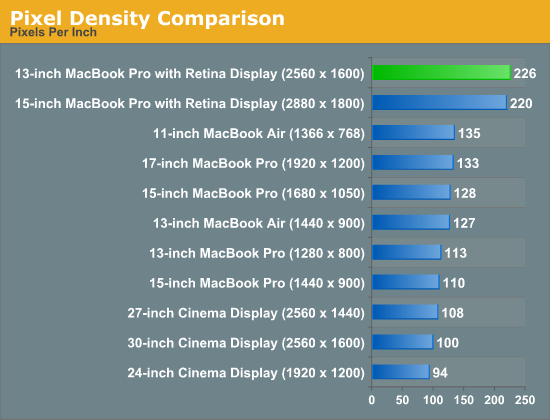
At first sight, the 13-inch rMBP panel is somehow less impressive than the old 15. Part of the problem is the 15-inch surface is just so much larger that it manages to deliver a pretty substantial impact. It's the problem of being compared to such an overachieving sibling: anything you do is just never good enough.
Despite its inability to outshine the 15-inch rMBP panel, the display on the 13-inch model is gorgeous. Viewing angles are great thanks to the use of IPS technology. Brightness and contrast are both top notch as well:
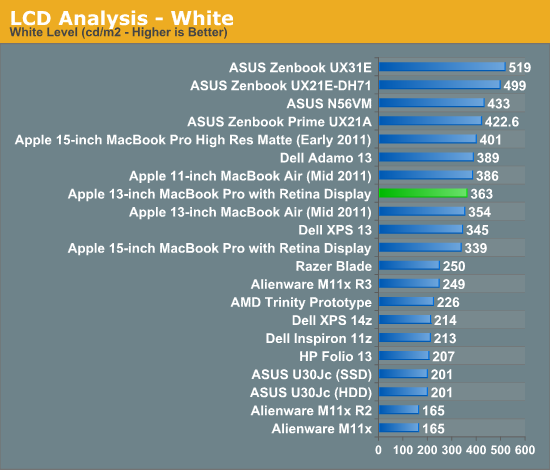
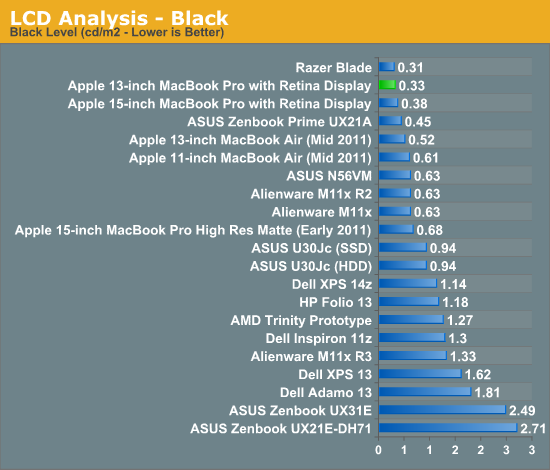
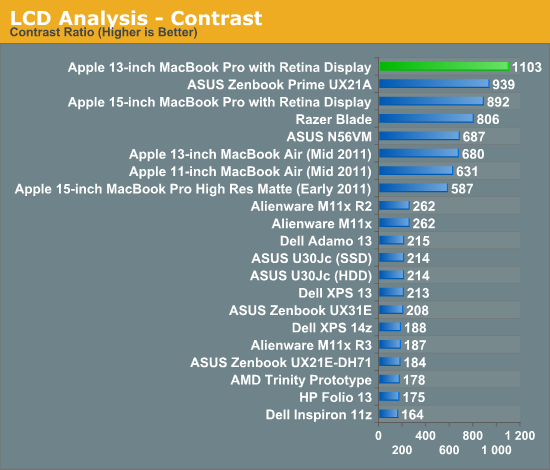
Color accuracy and gamut are both within the range of the 15-inch model, putting them among the best we've tested:

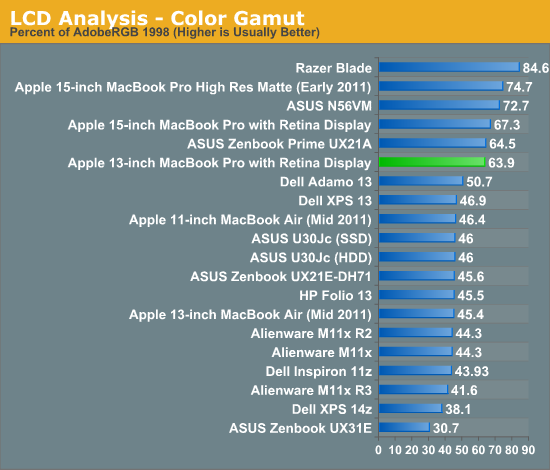
I also ran the 13-inch rMBP through our CalMAN smartphone/tablet workflow to compare it to Apple's iPad and iPhone 5. The results are very impressive (remember for the dE2000 values, lower numbers are better/more accurate colors):
| CalMAN Display Comparison | ||||||||
| Apple iPad (3rd gen) | Apple iPhone 5 | 13-inch rMBP (uncalibrated) | 13-inch rMBP (calibrated) | 15-inch rMBP (calibrated) | ||||
| Grayscale 200 nits Avg dE2000 | 3.7333 | 3.564 | 1.7825 | 1.6997 | 1.8074 | |||
| CCT Avg (K) | 6857K | 6925K | 6632K | 6545K | 6583K | |||
| Saturation Sweep Avg dE2000 | 3.193 | 3.591 | 2.1663 | 1.2269 | 1.335 | |||
| GMB Colorchecker Avg dE2000 | 3.0698 | 4.747 | 2.4521 | 1.0966 | 1.1714 | |||
Straight from the factory, the 13-inch rMBP display is a bit more accurate than what you get from the 3rd gen iPad and the iPhone 5. With an additional calibration pass using our i1 Pro spectrophotometer the rMBP display is in a different league. Once again we see relatively similar performance between the 13 and 15-inch rMBP displays.










79 Comments
View All Comments
James5mith - Tuesday, November 13, 2012 - link
One of the biggest advances the Windows OS made was moving from a strictly CPU driven windows management interface, to a GPU accelerated one. (Vista, Win7, Win8)It stopped things like the classic "trail of artifact windows" you could do when your old WindowsXP and earlier machines were bogged down. Since the desktop was drawn by the CPU, it wouldn't refresh properly until some CPU cycles were freed up.
Seems Apple did not learn from the past, and is now doomed to repeat it.
Ryan Smith - Tuesday, November 13, 2012 - link
Actually Apple introduced GPU accelerated window composition with Quartz Extreme nearly 10 years ago, a few years ahead of Microsoft.However there are several layers to GPU acceleration. The earliest solutions could do window composition on the GPU, but the contents of the windows themselves were still generated by the CPU. Since then both MS and Apple have been moving more and more of the workload on to the GPU as it makes sense to do so. But no one is 100% offloaded, so the CPU still plays a part and consequently can still be a bottleneck.
michal1980 - Tuesday, November 13, 2012 - link
The bias is strongsolipsism - Saturday, November 17, 2012 - link
Yes, the bias is strong... in you.<ul><li><a href="http://www.anandtech.com/tag/windows-8>http://w...
cjs150 - Tuesday, November 13, 2012 - link
But not yet. One maybe two generations to go before perfect.1. One obvious use of this will be to watch movies on go (especially on long business trips) but once again Apple ignores 1080p resolution (if there someone at Apple who hates this resolution, because they try and ignore it in every device they produce)
2. Card reader is flaky - is it because of chassis flex or just a bad reader?
3. storage needs to be bigger, I gues next generation will be 256gb.
4. A bit extra horse power obviously needed, but probably not a lot.
The real question though is as tablets get better, is there any point in the 13" Mac?
xTRICKYxx - Tuesday, November 13, 2012 - link
What software do you use to test the framerates of the browser?Jorange - Tuesday, November 13, 2012 - link
$1700 and laggy UI. Come on Apple fans admit that you buy their products for the image, and for fear of being seen as gauche in the eyes of your vapid clique. The best Apple zealots are those whom purchase the things on credit, look how wealthy I am, whilst paying off the monthly installments:)boblozano - Tuesday, November 13, 2012 - link
This is the first review that I've read that captures the essence of this machine -- it is a machine of excellent balance, and in that balance lies it's real reason for being.Came from a mid-2011 mbair (1.8 i7, 256gb), and before that a mid-2009 mbp 15. Workload is a mix of writing, photo editing (lr, ps, etc.), and some video creation. Lots of travel. Went to the mbair after good friends with a heavy dev emphasis swore it was excellent. It was/is.
Considered the 15 rMBP since the price is effectively the same, and there is obviously more of just about everything. But size for travel and general mobility was a significant concern (the air allowed me to switch from a full-size backpack to a much smaller messenger bag).
The reason why I've settled on 13 as just about perfect for my present usage is simple: with the increasing number of full-screen apps, 13" is just about perfect for writing in a full screen, while 15 just feels overwrought. Even better, with retina the photo and video editing remains very usable.
With that as a background, the 13" rMBP was a real step up in everything that I liked about the air, with hardly any compromise (small bit of weight). Ended up with the 2.9 I7, 512gb. Everything I do is faster, better (though definitely not cheaper), and that screen just makes you smile when opening it up to work. It is good enough that I'm even going back to using the device open on a stand (trying the new twelve south height-adjustable stand) when docked.
Sure it would be nice to have 4 cores and a discrete gpu (particularly for rendering), but as of now there's no doubt it would have compromised mobility and/or battery life. About the only indisputable criticism is one of value, but such is life.
Undoubtedly (and always) there'll be something much better down the road, maybe even only a year from now. Good. But as of today, this is the best computing device I've ever used on a daily basis.
caleblloyd - Tuesday, November 13, 2012 - link
Anand - the Primary Storage for the 13in MBA that you have listed on the table on the first page should be 128GB.repoman27 - Tuesday, November 13, 2012 - link
"In reality USB 3.0 is good for about 400 - 500MB/s (3.2Gbps - 4.0Gbps)..."The actual reality is that USB 3.0 provides a physical layer gross bit rate of 5 Gbit/s, and a physical layer net bit rate of 4 Gbit/s due to 8b/10b encoding. The net bit rate delivered to the application layer is unlikely to ever exceed 80% of that, or 400 MB/s, in the real world. Even using UASP, which clearly looks to be the case in these tests, I've never seen peak SuperSpeed USB transfer rates much in excess of 350 MB/s. USB 3.0 is good for 300 - 350 MB/s with the hardware shipping at this point, although we may see the upper bound approach 400 MB/s in the future.
"This is Intel's most capable Thunderbolt SKU as it takes four PCIe 2.0 lanes combined with DisplayPort and muxes them into four Thunderbolt channels (2 up/2 down) with two DP outputs."
This sentence has some problems as well. The DSL3510L has connections on the back end for 4 PCIe 2.0 lanes, 2 DisplayPort 1.1a sources and 1 DisplayPort 1.1a sink. On the front side it has four 10 Gbit/s, full-duplex Thunderbolt channels, 2 per port (i.e. 2 up/2 down per port or 4 up/4 down per controller). Each port can also operate in legacy DisplayPort signaling mode when a DisplayPort device is connected directly.
On another note, it's frustrating that Apple failed again at the SDXC card reader, and it appears to be a mechanical issue once again. iFixit's teardown photos seem to have omitted it, but if Apple used the same controller as in the 15-inch MBPR, then it's a Broadcom controller that supports SD 3.0 features such as SDXC and UHS-I paired with a PCIe 1.1 x1 back end. This should make it far more capable than a USB 2.0 based solution, but no, instead they made it useless because half the time it doesn't read a card at all when inserted.